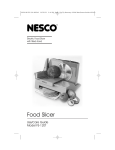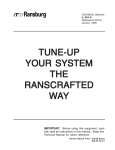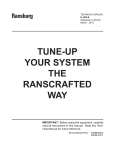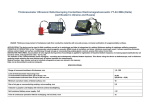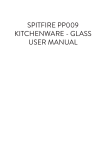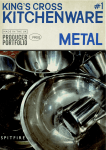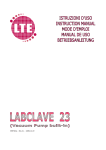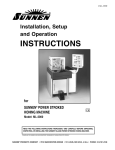Download NO. 2 Spray Techniques (Serv. Man. IL-211-D)
Transcript
TECHNICAL MANUAL IL-211-D Replaces (IL-211-C) NO. 2 PROCESS™ HANDGUN SPRAY TECHNIQUES Ransburg calls it No.2... but you'll say it does an...A-1 job! IMPORTANT: Before using this equipment, carefully read all instructions in this manual. Keep this Technical Manual for future reference. Technical Manual Price: $20.00 (U.S.) NOTE: This manual has been changed from revision IL-211-C to revision IL-211-D. Reasons for this change are noted under “Manual Change Summary” inside the back cover of this manual. IL-211-D No. 2 Process Handgun Spray Techniques CONTENTS PAGE NO. 2 PROCESS HANDGUN SPRAY TECHNIQUES: 1-11 ANGLES AND RECESSES......................................................................................................... 2 SPRAY PATTERNS..................................................................................................................... 3-4 FLAT SURFACES........................................................................................................................ 5-7 TUBULAR WORK....................................................................................................................... 8 USE THE RIGHT TECHNIQUE.................................................................................................. 9-10 SAFETY REQUIREMENTS......................................................................................................... 11 IL-211-D No. 2 Process Handgun Spray Techniques DO NOT GAMBLE! Reggie Ransburg says: “Before you get into the game, find out what the rules are.” Before operating, maintaining, or servicing any Ransburg electrostatic coating system, read and understand all of the technical and safety literature provided with Ransburg products. If you do not have the manuals and safety literature for your Ransburg system, contact your Ransburg representative. Reggie says: “Why gamble? If you know how to play the game, you’ll be a winner.” 1 IL-211-D No. 2 Process Handgun Spray Techniques ANGLES AND RECESSES General Rule: "Coat the most difficult areas first." While you work on the more difficult areas, wrap-around may take care of the less difficult areas on the target. A simple angle iron shape illustrating "difficult" and "easy" areas to coat. One characteristic of electrical charges is their attraction to the closest ground. The paint is attracted to the closest edges and will have only light or no coverage in the recess. → DIFFICULT ← EASY SOLUTION: Move the gun in closer so that the paint may be pulled directly from edge of the bell to the part. NOTE > Targets with very narrow and/or deep r ecesses are difficult to coat. Care must be taken to provide adequate coverage. IL-211-D 2 No. 2 Process Handgun Spray Techniques SPRAY PATTERNS The spray pattern varies in size from 10 inches minimum to 18 inches maximum (approximately). Variations depend on bell size, paint delivery, and paint electrical resistance. Minimum Maximum Voltage contactBrush out of position. Bell center probe has poor contact or damaged shaft resistor.* Large pattern with fair or poor atomization may be caused by excessive paint delivery.* * Insulating hub of bell has become conductive, i.e., moisture or conductive wash solvent. Fair pattern with "Slugs" - Possible causes: damaged bell edge or poor paint mixture. 3 IL-211-D No. 2 Process Handgun Spray Techniques Fair pattern with poor atomization - Excessive paint delivery or poor paint mixture. A good spray pattern - Has fine atomization at the edges and a small center hole. No pattern - Paint thrown from edge of bell; possible causes may be no gun voltage or paint grounding out. IL-211-D 4 Tune-Up Your System the RansCrafted Way FLAT SURFACES Poor Technique When the gun is moved in an arc, heavier films will result in the center of the target and lighter films at the edges. Also, more overspray is produced. Good Technique When the gun is moved parallel with the surface of the target, the operator has better control of the paint. Film uniformity is more easily controlled. "Normally, keep the gun at right angles to the target and move the gun parallel with the target surface." 5 IL-211-D Tune-Up Your System the RansCrafted Way ! CAUTION > If the gun is held too far from the target, the paint tends to "wrap-back" onto the gun and operator. The normal gun to target distance should be approximately 4 to 6 inches. This allows a good spray pattern to form and helps produce more uniform films. If the gun is held too close to the target (1 to 2 inches), the paint may not disperse properly, causing runs, sags, poor uniformity, and can also ground out the gun voltage. IL-211-D 6 No. 2 Process Handgun Spray Techniques FLAT SURFACES (Continued) On flat work, patterns may be overlapped as much as 50%. Another suitable technique, which is often used, is to move the gun in a slow spiraling path across the part, barely overlapping on the passes. Some overstroke at the edge of the target will help produce more wrap-around and better edge coverage. Attention: Chain-link fence, or other expanded metalware, is normally sprayed the same as flat work. Fences are coated easiest by spraying from the post side. 7 IL-211-D No. 2 Process Handgun Spray Techniques TUBULAR WORK The gun should normally be positioned about 4 to 6 inches from the part and held almost perpendicular to the target surface. Spraying too close to the part may cause runs and sags. Spraying too far away from the part may cause overspray or allow paint to wrap-back towards the gun. Moving the gun in a straight line may not always produce the most complete coverage or uniformity. (See example "A".) A slight waving or rotation of the gun can help to spread the paint around the part better and improve coverage. (See examples "B" and "C".) A B C NOTE > Small tubes (up to about 2-1/2 inches) often may be coated by wrap-around from one side. Larger parts are harder to wrap completely from one side because paint must miss target to wrap-around Example: Not complete wrap-around, but still good attraction and efficiency. IL-211-D 8 No. 2 Process Handgun Spray Techniques USE THE RIGHT TECHNIQUE No. 2 Process Handgun Overspray and drift are almost totally eliminated by the No. 2 Process Handgun. Using the same process as the automatic disk and bell systems, this gun delivers electrostatic wrap-around so effectively that many small, open targets can be painted from one side only, and finishing material savings can run 50% to 85% over conventional air spray. The following are basic electrostatic spray techniques. Depending on the type of work being sprayed, it may be necessary to change the technique slightly. 9 IL-211-D No. 2 Process Handgun Spray Techniques Coating the outside of the target first puts little paint on the inside. If the inside is coated last, double coating of the edges can result. The difficult area is coated first. While concentrating on the difficult area, much of the rest of the part is also coated. Thus, only the remaining uncoated areas need to be sprayed for adequate coating of the entire target area. AND NOW LET US SPRAY! IL-211-D 10 No. 2 Process Handgun Spray Techniques SAFETY REQUIREMENTS All conductive objects in the spray area MUST be grounded! • Keep all work holders and hooks free of coating material. The article being coated, work holders, and hooks MUST be grounded through the conveyor or other supporting structure. • Handgun operators MUST NOT wear gloves that insulate them from the gun handle. • All persons, including the operators, in spraying areas must NOT wear shoes that insulate them from the grounded conductive flooring. • All loose objects in the spraying area MUST be connected to ground. All solvents in the spraying area MUST be kept in an approved safety container that is connected to ground. In addition to these requirements, Operator MUST: • Turn off power supply prior to cleaning or working on equipment. • Never immerse guns in any liquid. • Have exhaust fans operating when spraying. Check That: • The spray booth, coating reservoir, and conveyor are grounded. 11 • The power supply is grounded and located outside of the spraying area. • The floor in the spraying area is conductive and is grounded. • Fire extinguishing equipment is provided and is operative. • The spraying area is clean and free of accumulated coating material. Good housekeeping must be maintained at all times. • No more than one gallon of solvent is kept in each solvent safety container and the total quantity of solvent in the spraying area is kept to the minimum consistent with operation. • The guns are operating properly (the short circuit currents are within the limits set forth in the instruction manual). IL-211-D MANUAL CHANGE SUMMARY This manual was published to replace Technical Manual IL-211-C No. 2 Process Handgun Spray Techniques, to make the following changes: 1. Document created in standard booklet formatting. IL-211-D Service Manual Price: $20.00 (U.S.) Manufacturing 1910 North Wayne Street Angola, Indiana 46703-9100 Telephone: 260/665-8800 Fax: 260/665-8516 Technical/Service Assistance Telephone: 800/ 233-3366 Fax: 419/ 470-2071 Technical Support Representative will direct you to the appropriate telephone number for ordering Spare Parts. © 2013 Ransburg. All rights reserved. Models and specifications subject to change without notice. Form No. IL-211-D Litho in U.S.A. 03/13
















